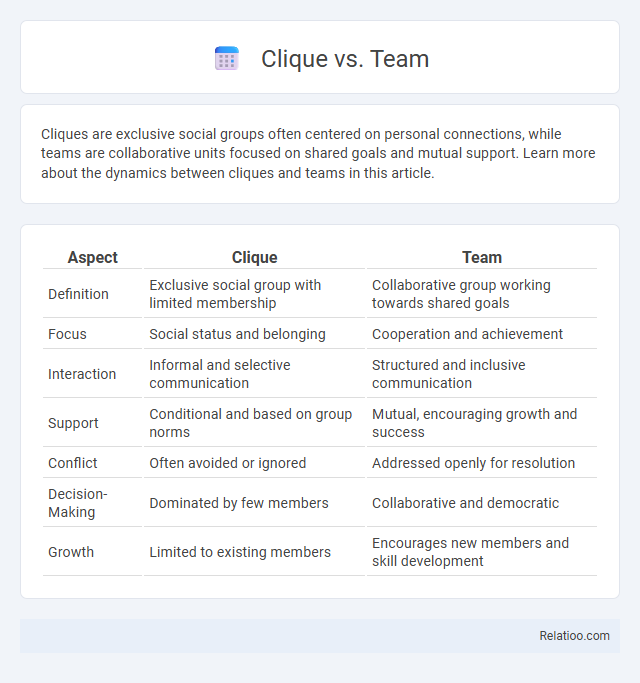Cliques are exclusive social groups often centered on personal connections, while teams are collaborative units focused on shared goals and mutual support. Learn more about the dynamics between cliques and teams in this article.
Table of Comparison
| Aspect | Clique | Team |
|---|---|---|
| Definition | Exclusive social group with limited membership | Collaborative group working towards shared goals |
| Focus | Social status and belonging | Cooperation and achievement |
| Interaction | Informal and selective communication | Structured and inclusive communication |
| Support | Conditional and based on group norms | Mutual, encouraging growth and success |
| Conflict | Often avoided or ignored | Addressed openly for resolution |
| Decision-Making | Dominated by few members | Collaborative and democratic |
| Growth | Limited to existing members | Encourages new members and skill development |
Understanding Cliques and Teams: Key Definitions
Cliques are small, exclusive groups formed based on shared interests or social bonds, often leading to exclusion of others, while teams consist of individuals collaboratively working towards common goals with defined roles and mutual accountability. Understanding cliques involves recognizing their social nature and potential to create divisions, whereas teams emphasize structured cooperation and collective success. Effective group dynamics rely on transforming clique behaviors into team-oriented strategies that foster inclusion and productivity.
Core Characteristics of a Clique
A clique is characterized by exclusive membership, strong internal bonds, and a shared sense of identity that often leads to social exclusion of outsiders. Unlike a team, which prioritizes collaboration and collective goals, a clique emphasizes loyalty and conformity within a close-knit group. Core characteristics of a clique include rigid social hierarchies, mutual favoritism, and resistance to external influence.
Essential Traits of a Team
A team is defined by essential traits such as collaboration, shared goals, and mutual accountability, contrasting with cliques that prioritize exclusivity and social bonding. Teams emphasize open communication and diverse skill sets to achieve collective objectives, fostering trust and a sense of purpose among members. Unlike cliques, teams promote inclusivity and equitable participation, driving productivity and sustained success.
Social Dynamics: Clique vs Team
Cliques exhibit exclusive social dynamics defined by strong in-group loyalty and clear boundaries that often lead to exclusion of outsiders, whereas teams emphasize collaboration, shared goals, and inclusive communication to achieve collective success. The social structure in a clique fosters conformity and hierarchical status, while a team promotes diversity of roles and mutual accountability. Understanding these contrasting dynamics is essential for managing group cohesion and performance in organizational and social contexts.
Inclusion vs Exclusion: The Membership Factor
Cliques often foster exclusion by limiting membership to a select group, reinforcing social barriers that can isolate others. Teams prioritize inclusion by encouraging diverse participation and collaboration to achieve shared goals. Your sense of belonging thrives in environments where inclusion is valued over exclusion, enhancing group cohesion and personal growth.
Collaboration and Productivity Comparisons
Teams foster collaboration through shared goals, diverse skills, and open communication, leading to higher productivity and innovation. Cliques often limit collaboration by creating exclusive groups that hinder information flow and reduce overall team cohesion. In contrast, effective teams balance strong interpersonal bonds with inclusivity, enhancing both collaboration and productivity across organizational projects.
Impact on Individual Growth
Cliques often limit individual growth by fostering exclusivity and social pressure, which can stifle personal development and creativity. Teams promote diverse collaboration, offering your skills opportunities to expand while encouraging mutual support and accountability. Groups strike a balance by allowing shared goals without intense social dynamics, helping individuals grow through both cooperation and independence.
Workplace Culture: Cliques vs Teams
Workplace culture thrives when teams foster inclusivity, collaboration, and shared goals, unlike cliques that promote exclusivity and hinder communication. Your productivity and job satisfaction improve significantly in a team-oriented environment where diverse perspectives are valued and conflicts are resolved constructively. Understanding the negative impact of cliques helps leaders create strategies to build stronger, unified teams that drive organizational success.
Conflict Resolution Approaches
Cliques often rely on informal, insider negotiation and exclusion to manage conflicts, which can limit open communication and resolution. Teams prioritize structured conflict resolution approaches such as active listening, mediation, and collaborative problem-solving to foster trust and shared objectives. Your ability to navigate these dynamics influences the effectiveness of resolving disagreements within any group setting.
Building a Healthy Team Environment
Building a healthy team environment hinges on fostering inclusion and open communication, contrasting sharply with the exclusionary nature of cliques that breed division and mistrust. Emphasizing shared goals and mutual respect cultivates collaboration and strengthens team cohesion, while cliques undermine productivity by creating silos and favoritism. Prioritizing team-building activities and transparent leadership strategies helps dismantle clique mentalities and promotes a culture of unity and collective success.

Infographic: Clique vs Team
 relatioo.com
relatioo.com